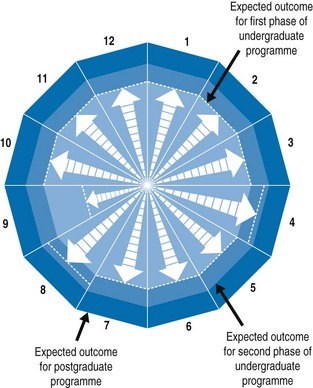Chapter 18 A vision of the type of doctor to be graduated and the associated learning outcomes are the first two of the ten questions to be answered in the development of a curriculum as described in Chapter 2. Only when these have been specified can we consider the content of the curriculum, the teaching and learning methods, the educational strategies and the approach to student assessment to be adopted (Fig. 18.1). The need for a more seamless transition between the undergraduate, postgraduate and continuing phases of education is now accepted. Implicit in this is a clear statement of the learning outcomes expected of the student or trainee, for example, the required communication skills, prescribing skills or mastery of practical procedures, at the end of each stage before they move on to the next phase of their training. Clarity is also necessary with regard to the required achievements by learners as they progress through each phase of the training programme including the 4, 5 or 6 years of the undergraduate curriculum. It is useful to chart a student’s progress towards each of the learning outcomes (Fig. 18.2). Fig. 18.2 A representation of progress by a first-phase student in relation to each of 12 learning outcome domains. The expected progress for each outcome is indicated by the inner target for the first phase of the programme, by the middle target for the second phase of the curriculum and by the outer target for postgraduate training (with permission from Harden RM: Learning outcomes as a tool to assess progression, Medical Teacher 29:678–682, 2007.) The student’s progress in each of the outcome domains can be looked at from different perspectives (Harden 2007): • Increased breadth, e.g. extension to new topics or different practice contexts • Increased difficulty, e.g. more advanced or in-depth consideration • Increased utility and application to medical practice, e.g. a move from theory to practice and integration of what is learned into the work of a doctor • Increased proficiency, e.g. more efficient performance with fewer errors and less need for supervision
Outcome-based education
A move from process to product
Why the move to OBE
Assessment of the learner’s progress and the continuum of education

![]()
Stay updated, free articles. Join our Telegram channel

Full access? Get Clinical Tree


Outcome-based education

